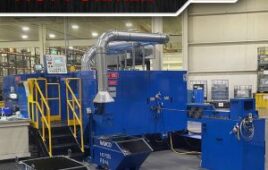Written by Jody Muelaner

One of many types of nut that resist loosening.
A lock nut is a nut that will resist loosening under vibration and torque. There are many types of lock nut but they can be broadly divided into those which use friction to prevent loosening and those that have some form of positive locking device.
Friction lock nuts
Lock nuts that use friction to resist loosening usually require a greater torque to both tighten and loosen, especially during the initial free rotation before they start to clamp down on the part. This means that they cannot be spun rapidly along a long length of thread, greatly increasing manual assembly time.
Examples include:
- A nylon lock nut, or nyloc nut, has a polymer collar, inserted into a recess at the top of the nut, which is slightly smaller than the outer thread diameter. This collar deforms elastically when the nut is tightened, causing friction. Because they rely on a polymer collar to provide friction, they are not reliable at elevated temperatures.
- Distorted thread locknuts have a section of thread that is shaped so that it must elastically deform to mate with the threaded shaft. This causes a surface normal force and therefore the increased friction required for locking. Because their construction is all metal they continue to work at elevated temperatures. Distorted thread locknuts may be categorized according to where the distorted thread is located or the shape of the distortion. For example, enter lock nuts have the distortion in the center, allowing them to be started from either end, while top lock nuts have a distorted thread at one end.
- A jam nut, or half nut, is a thinner nut, designed to be tightened, or ‘jammed’ against the primary nut. The jam nut should be tightened first and the main nut then fitted over the top.
Positive locking nuts
Lock nuts that use a positive locking device can be freely rotated to both tighten and loosen, they only lock when a positive action is performed to lock them in their current position, such as inserting a pin. This can enable both more rapid assembly and more secure fastening. Examples include:
- A castellated nut, or castle nut, is a positive locking nut with a cylindrical extension at one end containing notches. These bear against a pin inserted through the threaded shaft, preventing the nut from rotating. A castellated nut may be secured with a cotter pin, an R-clip or safety wire.
- A slotted nut is similar to a castellated nut but the notches are cut into the flat face of the nut.
A regular nut may also be locked by applying thread locker or by drilling and pinning.





Nice article. Good, quick read. What about Security Locknut, though! I am sure you have never heard of us. The Security Locknut is a fully reusable, prevailing torque locknut designed to separate loading and locking functions without damaging threads. Great for extreme vibratory and environmental conditions. And made in USA!